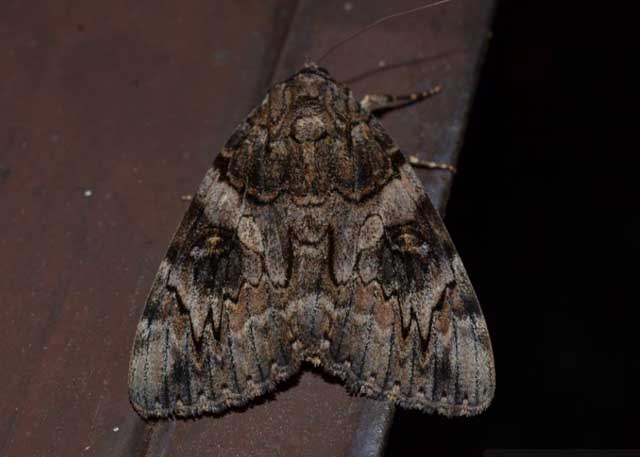Catocala piatrix
Catocala piatrix
kah-TOCK-uh-lahmmPEE-uh-tricks
(Grote, 1864)

The Penitent Underwing,
by Dale Clark, Texas .
This site has been created by
Bill Oehlke at oehlkew@islandtelecom.com
Comments, suggestions and/or additional information are welcomed by Bill.
| TAXONOMY:
Superfamily: Noctuoidea
Family: Noctuidae
Group: Noctuinina
Subfamily: Catocalinae
Genus: Catocala, Schrank, 1802
| |
MIDI MUSIC
"Moon River"
copyright C. Odenkirk
MIDI CITYON.OFF
<bgsound src="moon.mid" LOOP=FOREVER>
|
DISTRIBUTION:
Catocala piatrix
(wingspan: 68-84mm) flies from southern Ontario and
Quebec (rare) south through New Hampshire to Tennessee to
Florida and west to Texas and Arizona where it is replaced
by subspecies dionyza) and Oklahoma and north to Iowa, Nebraska,
South Dakota.
It has also been reported in Arkansas,
California (probably just subspecies dionyza),
Connecticut,
Delaware,
District of Columbia,
Georgia,
Illinois,
Indiana,
Kansas,
Kentucky,
Louisiana,
Maine,
Maryland,
Massachusetts,
Michigan,
Minnesota,
Mississippi,
Missouri,
New Jersey,
New Mexico,
New York,
North Carolina,
Ohio,
Pennsylvania,
Rhode Island,
South Carolina,
Vermont,
Virginia,
West Virginia and
Wisconsin.
David Wikle has taken piatrix dionyza at Cloverdale Muni Airport, Sonoma County,
California, 24 August 2003.
The forewing has a light-colored band/bar extending from the
subreniform spot along the am line to the costa. The
fringe of the hindwing is lightly barred and is lighter in color
than the deeper orange on the rest of wing.
There is usually a relatively dark area between the reniform spot and the pm line and the
wing veins tend to be dark and distinct in this area.
|
 |
The specimen above
and to the right has either just landed or is preparing for flight.
Photo courtesy of Paul
Pratt from
http://www.city.windsor.on.ca/ojibway/catocala.htm
Adults come in to lights and also respond to baits.
Visit Catocala piatrix, Willshire, Van Wert County, Ohio, August 1, 2012, Greg Roehm.
Visit Catocala piatrix, Woodlawn, Montgomery County, Tennessee, August 18, 2007,
courtesy of Tom Payne.
Visit Catocala piatrix, Buffalo County, Wisconsin, August 25, 2012,
Marcie O'Connor.
Visit Catocala piatrix, Londonderry, Rockingham County, New Hampshire, August 31, September 7, courtesy of
Deb Lievens.
Visit Catocala piatrix, Athol, Worcester County, Massachusetts, September 6, 2011, courtesy of Dave Small.
Visit Catocala piatrix, Caldwell County, western North Carolina,
October 24, 2009, courtesy
of Aubrey Scott.

The Penitent Underwing, Catocala piatrix,
Trout Valley, (McHenry County)
Illinois,
August 17-26, sugar bait, courtesy of Scott Boutilier.
FLIGHT TIMES AND PREFERRED FOOD PLANTS:
In northern
portions of its range, Catocala piatrix flies as a single
generation with moths on the wing from July to early November.
The Catocala piatrix caterpillar shows a preference for
Juglans nigra (black walnut) and Juglans cinerea
(butternut) and Carya (hickory).

Catocala piatrix, Devonwood, Windsor, Ontario, August 29, 2008,
courtesy of Maurice Bottos. copyright.
ECLOSION:
Adults eclose from pupae under surface litter.

Catocala piatrix female, Louisiana, courtesy of
Vernon A. Brou.

Catocala piatrix, 72mm, Mason, Ingham County, Michigan,
bait, August 14, 1996, courtesy of Harry King.

Catocala piatrix, 72mm, (verso), Mason, Ingham County, Michigan,
bait, August 14, 1996, courtesy of Harry King.
Visit C. neogama / C. subnata / C.piatrix comparison.
SCENTING AND MATING:
Catocala piatrix females
emit an airbourne pheromone and males use their antennae to track the
scent plume. Catocala piatrix is replaced by Catocala piatrix dionyza from Arizona to California.

Catocala piatrix dionyza, Hollywood, Los Angeles County, California,
August 17, 2012, courtesy of Tim Bonebrake.

Catocala piatrix dionyza H. Edwards, 1885,
courtesy of Bruce Walsh, Arizona.

Catocala piatrix dionyza, Paulden, Yavapai County, Arizona,
77mm, September 6, 2008, courtesy of Evan Rand.
EGGS, CATERPILLARS, COCOONS AND PUPAE:
Eggs are deposited on tree bark in the fall and hatch the following spring.
Catocala piatrix dionyza fourth instar larva on walnut. Image courtesy of
Ron Nelson of Gabriel Larrabee rearings. |
 |
Larval Food Plants
Listed below are primary food plant(s) and alternate food plants.
It is hoped that this alphabetical listing followed by the common
name of the foodplant will prove useful. The list is not exhaustive,
although some species seem very host specific.
Experimenting with closely related foodplants is worthwhile.
Carya
Juglans cinerea.....
Juglans nigra
|
Hickory
Butternut
Black walnut
|
Return to Main Index










